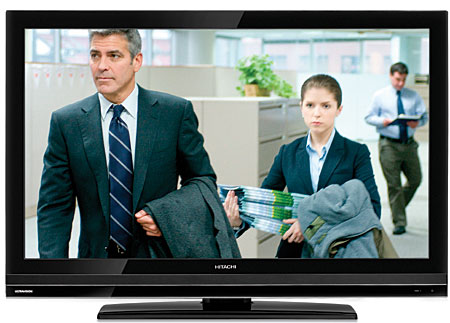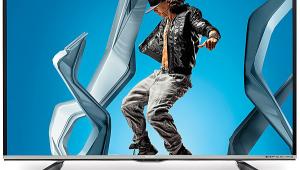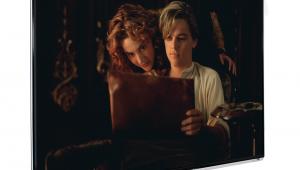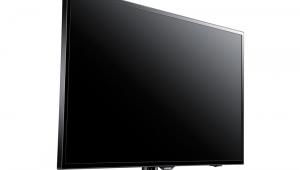Hitachi UltraVision L46S603 LCD HDTV
Keeping It Affordable

It’s been an eternity in video-years since I last reviewed a Hitachi HDTV. In fact, the last one I reviewed was in November 2002 for Stereophile Guide to Home Theater. The subject then was the 51-inch Hitachi 51SWX20B HD-ready CRT RPTV. It was the smallest sibling in what was arguably the best line of CRT RPTVs Hitachi—and perhaps anyone else—ever produced.
However, that old CRT design weighed in at a backbreaking 238 pounds, dominated a room, and sold for $3,000. Hitachi has moved on to new digital technologies along with the rest of the industry. This LCD model has a screen that’s 5 inches smaller than that CRT (there’s also a $1,899 55-incher in the UltraVision LCD lineup), weighs just a smidgen over 56 pounds, sells for $1,399, and will fit on a sturdy bookshelf.
Conventional LCD
The UltraVision series employs traditional cold cathode fluorescent lamp (CCFL) backlighting rather than that new kid on the block, LED. CCFL may not offer much buzz for the marketing department, but it does keep the price down.
Separate side and rear jack panels offer a total of five HDMI 1.3 inputs, two component video inputs, and an RGB/computer port. The Hitachi’s only multimedia feature is a USB input on the side panel, which lets you access service updates and view photos from a USB drive.
The L46S603 includes seven selectable picture modes: Dynamic, Standard, Movie, Custom, Game, Pro-Day, and Pro-Night. You can make changes to any of the first five, but when you do, those changes become your new Custom mode. If you change the Dynamic, Standard, or Movie modes, the Custom mode’s name in the selection menu will change, for example, to Custom-Movie.
The two Pro modes are the only ones that offer full red, green, and blue high (drive) and low (cutoff) White Balance (calibration) controls. The other modes offer only three fixed Color Temp selections: High, Medium, and Standard. The latter is by far the closest to accurate.
In addition to White Balance, the Pro modes include a Blue Only mode to help you set the Color and Tint controls to their technically correct settings.
Apart from the usual video adjustments, the L46S603 features several other controls. It includes two types of noise reduction, three gamma options, and Dynamic Gamma. It also has a Light Sensor that adjusts the image brightness according to the brightness of the room, and a Picture Energy Saving control (Min, Medium, Max) that reduces energy consumption. I left the latter on Min for this review and set the Light Sensor to Off.
There’s an Auto aspect ratio setting, but it wasn’t consistently effective. You’ll still need to experiment with the Aspect control to get a properly proportioned image to fill the screen from left to right. It’s nearly always Full for widescreen DVDs and Blu-ray Discs, but it can vary with other sources.
Reel120 Motion is Hitachi’s 120-hertz, motion-smoothing feature. When it’s engaged with a 24-frame-per-second source (such as a Blu-ray Disc), the L46S603 interpolates four new frames for each source frame to reach the set’s native 120-Hz refresh rate. If you turn off Reel120 Motion, the set will repeat each real frame four times (a total of five frames) to reach the 120-Hz refresh rate.
For a 60-fps source (or a source such as 480i/30 converted by the Hitachi to the set’s native resolution—1920 by 1080p/60), the above still holds true. However, now it generates only one interpolated or repeated frame to reach the set’s 120-Hz refresh rate.
Reel120 Motion does what it is intended to do—it produces smoother motion and reduces motion blur—and it does it exceptionally well. Many viewers (including me) can’t stand the soap opera or sitcom look that this sort of processing gives to film-based material. I turned it off for all of my testing and viewing.
You can code the Hitachi’s remote to control four components apart from the set. The remote isn’t backlit, and it lacks buttons for direct input selection. Many of the controls step the onscreen menus only one way. In order to reach a nearby setting that’s one or two steps in the wrong direction, you have to go around the horn. This is particularly annoying when you move from the Pro-Night to the Pro-Day picture mode. It forces you to cycle through all of the other picture modes to get there, including the ultrabright Dynamic and Game options.
Modal Analysis
While the two Pro modes offer the most control, they were a pain to use since most of their menu adjustments are locked out. You can access them, but you have to go through several steps to get to them. This process includes entering a four-digit, user-adjustable code. The locking feature keeps remote-happy family members from trashing your carefully chosen Pro settings. But it also makes small tweaks a chore—particularly if you’re in a darkened room with a remote that has no backlighting.

When you enter the Pro menu, the set defaults to Pro-Day. If you were watching—and want to modify—Pro-Night, it’s easy to forget this default change and accidentally alter Pro-Day instead. The Pro menu also times out too fast; I had to re-enter it so often while I set up and calibrated the set that the multi-step entry procedure became second nature. But it was still no fun.
Setup and Performance
The set’s built-in audio is rather thin and colored. A wide range of audio controls helps a little, and uncritical viewers won’t complain. Still, as with most flat-panel displays, you’ll need a decent external sound system if you want a real home theater experience.
The Hitachi’s video processing results were below average (see the Video Test Bench). It failed our standard 2:2 and 3:2 deinterlacing tests. It also failed the HD luma (black-and-white) bandwidth test, since it didn’t show any horizontal resolution lines on the highest frequency burst. It passed the chroma (color) bandwidth test. (The required chroma bandwidth is only half that of luma.)
None of these technical shortcomings produced any consistent problems with normal program material, either SD or HD. The Hitachi passed the Vatican wall and staircase tests in Mission: Impossible III without a trace of moiré. The artifacts on the difficult, non-anamorphic letterboxed transfer of Titanic (480i) were no more obvious than what I see on most flat-panel displays.
One issue that I saw, as it is on all LCD sets we’ve tested, was off-axis performance. The problem was more visible on dark scenes than lighter ones. It was also more evident in a properly calibrated Pro-Night mode than in one of the torch modes, like Dynamic. (That’s why you won’t notice this issue in a showroom.) The Hitachi passed my three-on-a-couch test—that is, whether three viewers seated on a normalsized sofa about 8 feet away from the screen each see a reasonably consistent picture. But you’ll still want to grab that center seat.
The factory default settings for my preferred Pro-Night mode were poor, with wildly hyped color and badly crushed blacks. But this isn’t a unique problem with out-of-the-box HDTVs.




























































